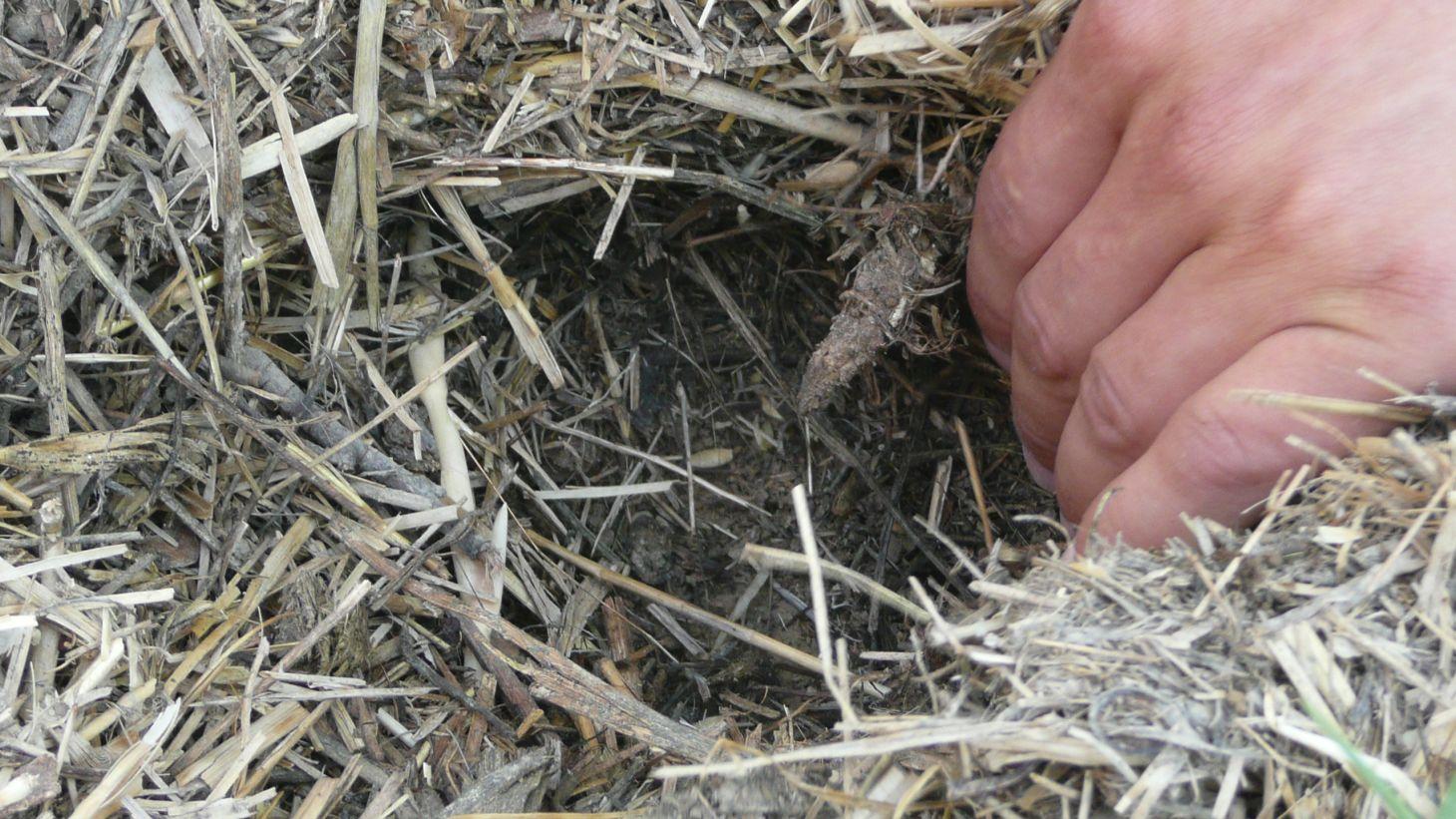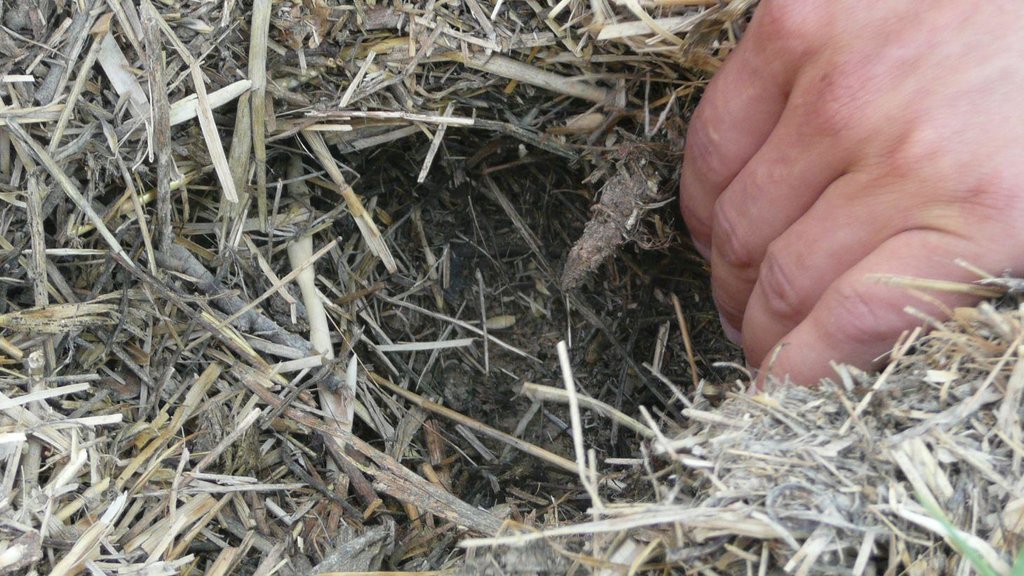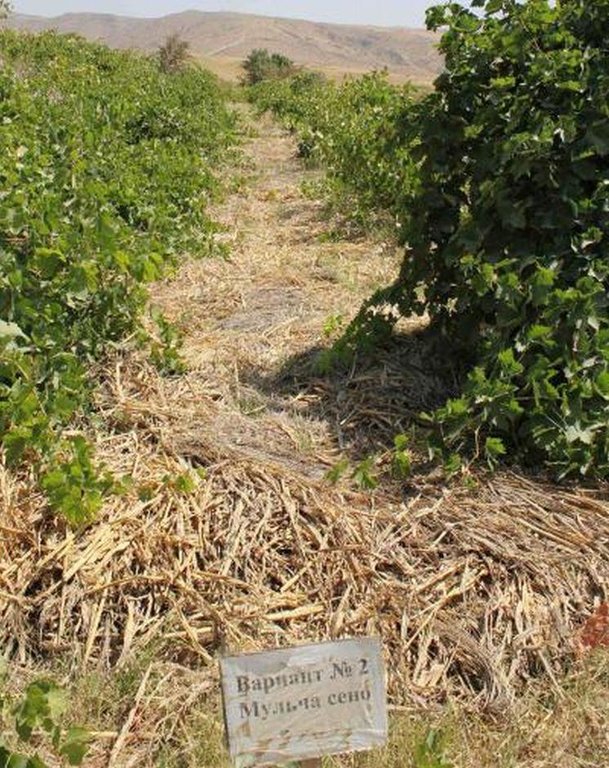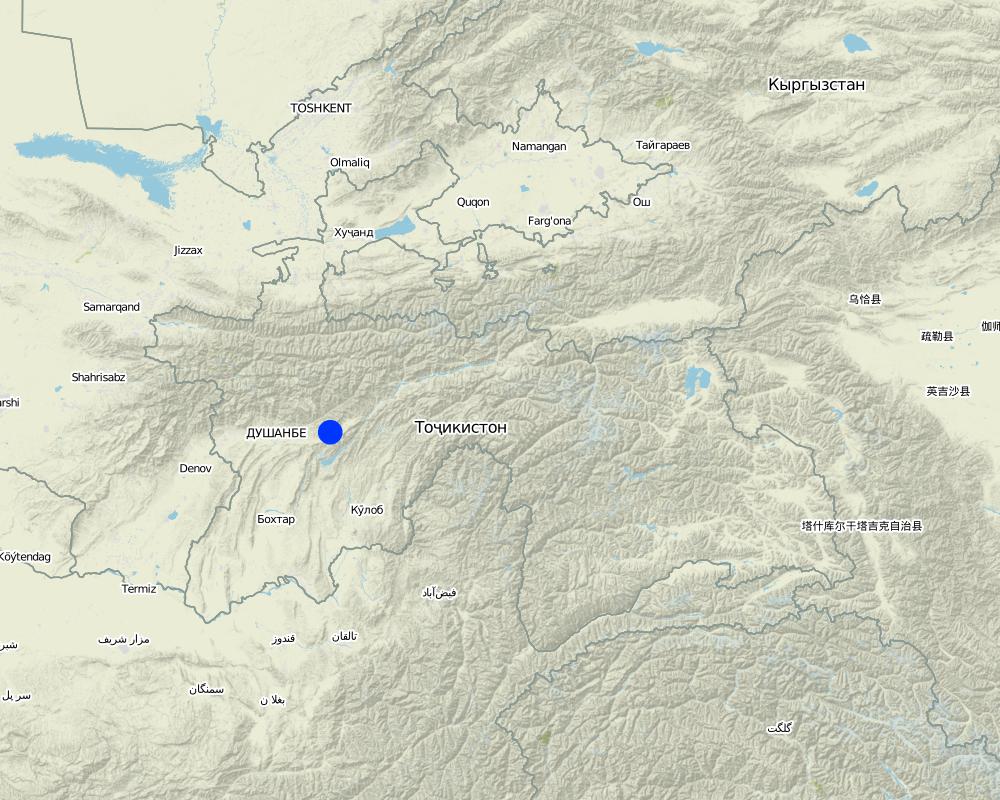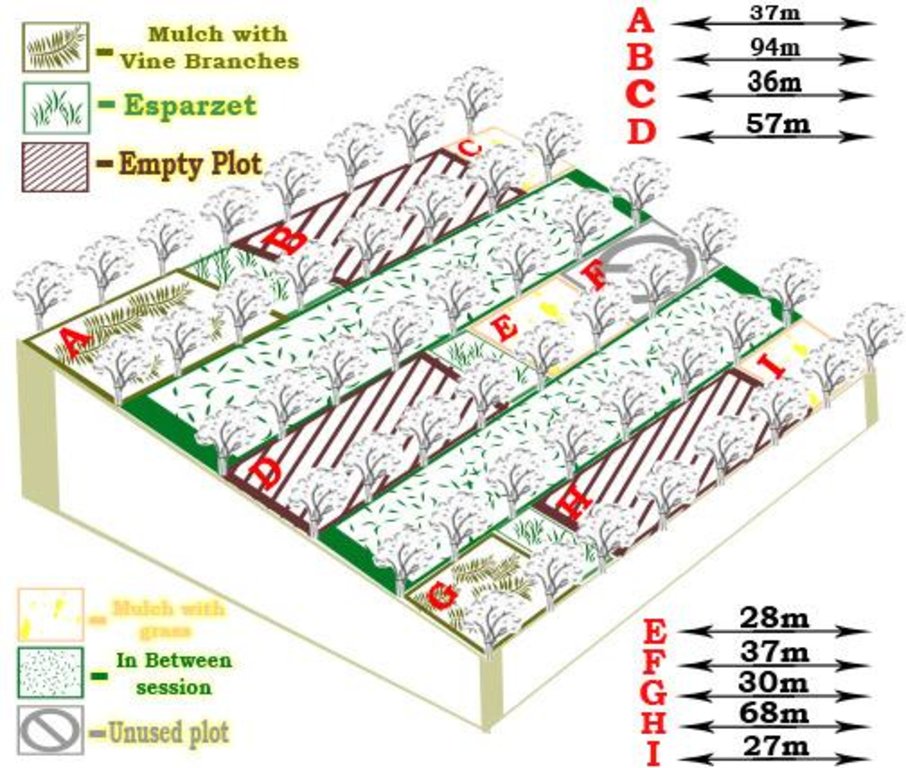Mulching in rainfed vineyards on terraces in the loess hill zone [塔吉克斯坦]
- 创建:
- 更新:
- 编制者: Qobiljon Shokirov
- 编辑者: –
- 审查者: David Streiff, Alexandra Gavilano
Mulcha Sino
technologies_1111 - 塔吉克斯坦
查看章节
全部展开 全部收起1. 一般信息
1.2 参与该技术评估和文件编制的资源人员和机构的联系方式
SLM专业人员:
Boev Jahonbek
Tajik Soil Institute
塔吉克斯坦
有助于对技术进行记录/评估的机构名称(如相关)
Tajik Soil Insitute (Tajik Soil Institute) - 塔吉克斯坦有助于对技术进行记录/评估的机构名称(如相关)
NCCR North-South (NCCR North-South) - 吉尔吉斯斯坦1.3 关于使用通过WOCAT记录的数据的条件
编制者和关键资源人员接受有关使用通过WOCAT记录数据的条件。:
是
2. SLM技术的说明
2.1 技术简介
技术定义:
This technology consists of vineyards plots that are mulched with grass and established on terraced land in the loess hills of Tajikistan.
2.2 技术的详细说明
说明:
On the terrain of the Tajik Soil Institut's research station in Karsang, Faizabad District, Tajikistan, a vineyard was established on forward sloping terraces with about 12° inclination on land formerly used as extensive pastures. This technology dates back to the times of the Soviet Union in 1968. Bulldozers were used to establish the terraces.
Before the planting of vines the soil was ploughed. Local vine sorts were used for the plantation and intercropping is done with wheat and fodder crops. About 1300 vine seedlings were planted per hectare.
Purpose of the Technology: Mulching treatment with grass was initiated to increase soil moisture in the soil, improve soil quality such as soil organic matter and other elements and protect soil from erosion by water and wind.
Establishment / maintenance activities and inputs: Mulching with grass was set up by the Tajik Soil Institute and but has been maintained by the farmers who lease the land. Mulching with grass is relatively easy but can be very challenging; depending on the availability of resources. First, plots between the vineyard rows were ploughed by using animal power, in most cases horses. Natural grasses were cut from the property of the research station and applied as a mulch in between plots within the designated vineyard plots. Since then the experiment has been maintained by the farmers and over the last ten years layer of mulch with grass has been growing and building up the top soil layer. This layer of mulch prevents rainwater from eroding the top soil, improves soil organic carbon, provides shade to plant roots, and most importantly keeps soil moisture moderately in hot summer months, which is very essential in these rainfed areas.
Natural / human environment: The terraces have greatly helped to reduced soil erosion and the vines supported this effect in further stabilising the soil. Soil humidity has improved through increased soil moisture and reduced evaporation due to mulching throughout the year. As the vineyard was established on pasture land, a disadvantage is the reduced grazing land area. The disadvantage of mulching is that no inter cropping between the vines can take place for several years.
In summer of 2011, WOCAT questionnary was used to analyze and evaluate current conditions of the vineyard mulching treatment. At the same time proper soil samples were taken from the plots with mulch and control plots in 0-15 and 15-30cm for further comparison for soil organic carbon (SOC). All together 240 soil samples were taken from eight different plots and each have been analyzed for soil SOC content.
From this study it was revealed that plots with mulch has significantly higher SOC content than control plots. In average, plots with mulch consisted of 1.3% SOC and control plots in average contained 0.4% SOC within the 0-15cm depths. Average SOC content for plots with mulch and control plots were observed but there were no significant difference in 30cm depth, both contained 0.4-0.5% of SOC.
2.3 技术照片
2.5 已应用该技术的、本评估所涵盖的国家/地区/地点
国家:
塔吉克斯坦
区域/州/省:
RRS
有关地点的进一步说明:
Faizabad, Javonon, Karsang
具体说明该技术的分布:
- 均匀地分布在一个区域
如果不知道精确的区域,请注明大致覆盖的区域:
- < 0.1 平方千米(10 公顷)
注释:
Total area covered by the SLM Technology is 0.07 km2.
Map
×2.6 实施日期
如果不知道确切的年份,请说明大概的日期:
- 不到10年前(最近)
2.7 技术介绍
详细说明该技术是如何引入的:
- 在实验/研究期间
注释(项目类型等):
The vineyard was originally set up 60 years ago but the mulching experiment within the vineyard was introduced around 2000-2003.
3. SLM技术的分类
3.1 该技术的主要目的
- 减少、预防、恢复土地退化
3.2 应用该技术的当前土地利用类型
同一土地单元内混合使用的土地::
是
具体说明混合土地使用(作物/放牧/树木):
- 农林业

农田
- 多年一作(非木材)
- 乔木与灌木的种植
乔木和灌木种植 - 指定作物:
- 葡萄
每年的生长季节数:
- 1
具体说明:
Longest growing period from month to month: April to November

牧场

森林/林地
注释:
Major land use problems (compiler’s opinion): soil erosion through wind and water, soil moisture loss, soil nutrient mining
Major land use problems (land users’ perception): soil fertility and humidity decline, lack of technical equipment, low productivity of non-irrigated land on slopes when used in a conventional way as cropland of extensive pasture
Future (final) land use (after implementation of SLM Technology): Mixed: Mf: Agroforestry
3.3 由于技术的实施,土地使用是否发生了变化?
由于技术的实施,土地使用是否发生了变化?:
- 是(请在技术实施前填写以下有关土地利用的问题)
同一土地单元内混合使用的土地::
是
具体说明混合土地使用(作物/放牧/树木):
- 农林业

牧场
注释:
Future (final) land use (after implementation of SLM Technology): Mixed: Mf: Agroforestry
3.4 供水
该技术所应用土地的供水:
- 雨养
3.5 该技术所属的SLM组
- 农业林学
- 改良的地面/植被覆盖
- 横坡措施
3.6 包含该技术的可持续土地管理措施

农艺措施
- A1:植被和土壤覆盖层
- A3:土壤表面处理
A3:区分耕作制度:
A 3.1:免耕

植物措施
- V1:乔木和灌木覆盖层

结构措施
- S1:阶地

管理措施
- M1:改变土地使用类型
注释:
Main measures: agronomic measures, vegetative measures
Secondary measures: structural measures, management measures
Type of agronomic measures: mulching, breaking compacted topsoil, zero tillage / no-till
Type of vegetative measures: aligned: -contour
3.7 该技术强调的主要土地退化类型

土壤水蚀
- Wt:表土流失/地表侵蚀
- Wg:冲沟侵蚀/沟蚀
注释:
Main type of degradation addressed: Wt: loss of topsoil / surface erosion
Secondary types of degradation addressed: Wg: gully erosion / gullying
Main causes of degradation: soil management (Plowing), overgrazing, Heavy / extreme rainfall (intensity/amounts)
Secondary causes of degradation: wind storms / dust storms, droughts, governance / institutional (common grazing land in the vicinity of the village regulated management)
3.8 防止、减少或恢复土地退化
具体数量名该技术与土地退化有关的目标:
- 防止土地退化
- 减少土地退化
注释:
Main goals: prevention of land degradation
Secondary goals: mitigation / reduction of land degradation, rehabilitation / reclamation of denuded land
4. 技术规范、实施活动、投入和成本
4.1 该技术的技术图纸
技术规范(与技术图纸相关):
ocation: Faizabad, Tajikistan. RRS
Date: September, 2011
Technical knowledge required for field staff / advisors: moderate
Technical knowledge required for land users: moderate
Main technical functions: control of raindrop splash, control of dispersed runoff: impede / retard, improvement of ground cover, increase in organic matter, increase in nutrient availability (supply, recycling,…), increase / maintain water stored in soil
Secondary technical functions: control of dispersed runoff: retain / trap, improvement of surface structure (crusting, sealing), stabilisation of soil (eg by tree roots against land slides), increase of infiltration, water harvesting / increase water supply, increase of biomass (quantity)
Diversion ditch/ drainage
Material: earth
Mulching
Material/ species: grass
Quantity/ density: 15-20cm
Remarks: mulch layer thickness (15-20cm)
Breaking compacted topsoil
Material/ species: loosing of soil around vines, yearly
Zero tillage / no-till
Material/ species: zero tillage between the vines on the terraces
Aligned: -contour
Vegetative material: F : fruit trees / shrubs
Number of plants per (ha): 1300
Spacing between rows / strips / blocks (m): 3
Vertical interval within rows / strips / blocks (m): 2
Fruit trees / shrubs species: vineyards "rosevitaiti", improved local sorts
Terrace: bench level
Width of bunds/banks/others (m): 3
Vegetation is used for stabilisation of structures.
作者:
Ibrohimov Huseyn
4.2 有关投入和成本计算的一般信息
具体说明成本计算所用货币:
- 美元
如相关,注明美元与当地货币的汇率(例如1美元=79.9巴西雷亚尔):1美元=:
-2.13
注明雇用劳工的每日平均工资成本:
6.5
4.3 技术建立活动
| 活动 | 时间(季度) | |
|---|---|---|
| 1. | Planting | |
| 2. | Terracing by bulldozer | late autumn / early spring |
4.4 技术建立所需要的费用和投入
| 对投入进行具体说明 | 单位 | 数量 | 单位成本 | 每项投入的总成本 | 土地使用者承担的成本% | |
|---|---|---|---|---|---|---|
| 劳动力 | Planting | Persons/day | 13.0 | 6.5 | 84.5 | |
| 劳动力 | Terracing by bulldozer | hours | 16.0 | 2.81222 | 45.0 | |
| 设备 | Bulldozer rent | hours | 16.0 | 0.8125 | 13.0 | |
| 植物材料 | Seedlings | Seeds/ha | 1300.0 | 0.5 | 650.0 | |
| 肥料和杀菌剂 | Fertilizer | kg | 5.0 | 1.0 | 5.0 | |
| 施工材料 | Grass | tons | 1.0 | 165.0 | 165.0 | |
| 技术建立所需总成本 | 962.5 | |||||
| 技术建立总成本,美元 | -451.88 | |||||
4.5 维护/经常性活动
| 活动 | 时间/频率 | |
|---|---|---|
| 1. | cutting of grass | spring/once a year |
| 2. | soil loosening around the trees | |
| 3. | Mulching | spring (end of April/beginning of May) |
| 4. | Cutting the grass | 1 |
| 5. | Protecting the vineyard from animals | autumn to spring |
4.6 维护/经常性活动所需要的费用和投入(每年)
| 对投入进行具体说明 | 单位 | 数量 | 单位成本 | 每项投入的总成本 | 土地使用者承担的成本% | |
|---|---|---|---|---|---|---|
| 劳动力 | Cutting of grass | Persons/day | 5.0 | 6.5 | 32.5 | |
| 劳动力 | Soil loosening | Persons/day | 2.0 | 6.5 | 13.0 | |
| 劳动力 | Cutting the grass 2nd time | Persons/day | 4.0 | 6.5 | 26.0 | |
| 设备 | Mulching | tons | 1.0 | 86.0 | 86.0 | |
| 设备 | Scissors | ha | 1.0 | 60.0 | 60.0 | |
| 技术维护所需总成本 | 217.5 | |||||
| 技术维护总成本,美元 | -102.11 | |||||
注释:
Machinery/ tools: scissors, hoes
The establishment of the vineyard took place in Soviet times and costs were born by the Soil Institute, which is a state institution. However, costs were calculated based on current costs (2011).
5. 自然和人文环境
5.1 气候
年降雨量
- < 250毫米
- 251-500毫米
- 501-750毫米
- 751-1,000毫米
- 1,001-1,500毫米
- 1,501-2,000毫米
- 2,001-3,000毫米
- 3,001-4,000毫米
- > 4,000毫米
农业气候带
- 半干旱
Thermal climate class: temperate
5.2 地形
平均坡度:
- 水平(0-2%)
- 缓降(3-5%)
- 平缓(6-10%)
- 滚坡(11-15%)
- 崎岖(16-30%)
- 陡峭(31-60%)
- 非常陡峭(>60%)
地形:
- 高原/平原
- 山脊
- 山坡
- 山地斜坡
- 麓坡
- 谷底
垂直分布带:
- 0-100 m a.s.l.
- 101-500 m a.s.l.
- 501-1,000 m a.s.l.
- 1,001-1,500 m a.s.l.
- 1,501-2,000 m a.s.l.
- 2,001-2,500 m a.s.l.
- 2,501-3,000 m a.s.l.
- 3,001-4,000 m a.s.l.
- > 4,000 m a.s.l.
5.3 土壤
平均土层深度:
- 非常浅(0-20厘米)
- 浅(21-50厘米)
- 中等深度(51-80厘米)
- 深(81-120厘米)
- 非常深(> 120厘米)
土壤质地(表土):
- 中粒(壤土、粉土)
表土有机质:
- 中(1-3%)
如有可能,附上完整的土壤描述或具体说明可用的信息,例如土壤类型、土壤酸碱度、阳离子交换能力、氮、盐度等。:
Soil fertility is medium
Soil drainage / infiltration is poor
5.4 水资源可用性和质量
地下水位表:
5-50米
地表水的可用性:
中等
水质(未处理):
良好饮用水
5.5 生物多样性
物种多样性:
- 低
5.6 应用该技术的土地使用者的特征
生产系统的市场定位:
- 生计(自给)
非农收入:
- 低于全部收入的10%
个人或集体:
- 员工(公司、政府)
机械化水平:
- 手工作业
- 机械化/电动
性别:
- 男人
说明土地使用者的其他有关特征:
Annual population growth: 1% - 2%
Subsistence (self-supply) is supported by the local Institution.
All three levels of mechanization are existing.
5.7 应用该技术的土地使用者使用的平均土地面积
- < 0.5 公顷
- 0.5-1 公顷
- 1-2 公顷
- 2-5公顷
- 5-15公顷
- 15-50公顷
- 50-100公顷
- 100-500公顷
- 500-1,000公顷
- 1,000-10,000公顷
- > 10,000公顷
这被认为是小规模、中规模还是大规模的(参照当地实际情况)?:
- 中等规模的
5.8 土地所有权、土地使用权和水使用权
土地所有权:
- 州
土地使用权:
- 租赁
- research
- research
注释:
harvest: 50% to state / 50% to land user
5.9 进入服务和基础设施的通道
健康:
- 贫瘠
- 适度的
- 好
教育:
- 贫瘠
- 适度的
- 好
技术援助:
- 贫瘠
- 适度的
- 好
就业(例如非农):
- 贫瘠
- 适度的
- 好
市场:
- 贫瘠
- 适度的
- 好
能源:
- 贫瘠
- 适度的
- 好
道路和交通:
- 贫瘠
- 适度的
- 好
饮用水和卫生设施:
- 贫瘠
- 适度的
- 好
金融服务:
- 贫瘠
- 适度的
- 好
6. 影响和结论性说明
6.1 该技术的现场影响
社会经济效应
生产
作物生产
饲料生产
生态影响
水循环/径流
地表径流
多余水的排放
蒸发
土壤
土壤水分
土壤覆盖层
土壤流失
土壤结壳/密封
土壤压实
土壤有机物/地下C
生物多样性:植被、动物
有益物种
注释/具体说明:
earthworms
其它生态影响
Hazards towards adverse events
注释/具体说明:
drought
6.3 技术对渐变气候以及与气候相关的极端情况/灾害的暴露和敏感性(土地使用者认为的极端情况/灾害)
渐变气候
渐变气候
| 季节 | 增加或减少 | 该技术是如何应对的? | |
|---|---|---|---|
| 年温度 | 增加 | 好 |
气候有关的极端情况(灾害)
气象灾害
| 该技术是如何应对的? | |
|---|---|
| 局地暴雨 | 好 |
| 局地风暴 | 好 |
气候灾害
| 该技术是如何应对的? | |
|---|---|
| 干旱 | 不好 |
水文灾害
| 该技术是如何应对的? | |
|---|---|
| 比较和缓的(河道)洪水 | 不好 |
注释:
Different types of mulching are currently being tested to increase soil moisture storage, to build up soil organic matter and thus infiltration capacity and soil fertility properties.
6.4 成本效益分析
技术收益与技术建立成本相比如何(从土地使用者的角度看)?
短期回报:
稍微积极
长期回报:
积极
技术收益与技术维护成本/经常性成本相比如何(从土地使用者的角度看)?
短期回报:
中性/平衡
长期回报:
积极
注释:
Farmers have noted that usually change can be seen within few years after the technology has established.
6.5 技术采用
- 1-10%
如若可行,进行量化(住户数量和/或覆盖面积):
10 households (3 percent of stated area)
在所有采用这项技术的人当中,有多少人是自发的,即未获得任何物质奖励/付款?:
- 91-100%
注释:
100% of land user families have adopted the Technology without any external material support
10 land user families have adopted the Technology without any external material support
Comments on spontaneous adoption: Overall acreage of the all field are roughly 3 hectares.
There is a little trend towards spontaneous adoption of the Technology
6.7 该技术的优点/长处/机会
| 土地使用者眼中的长处/优势/机会 |
|---|
| Vineyards are adapted to climate and give consistently good harvest. |
| Between the rows there is an additional harvest thanks to intercropping. |
| 编制者或其他关键资源人员认为的长处/优势/机会 |
|---|
| Efficient soil protection. |
|
Very practical and easily adaptable in villages, where grass is available. How can they be sustained / enhanced? At the same time grass can become deficit in villages, because of high number of livestock. In that cases small scale mulching is recommended with rotation system. |
6.8 技术的弱点/缺点/风险及其克服方法
| 编制者或其他关键资源人员认为的弱点/缺点/风险 | 如何克服它们? |
|---|---|
| Technology is very practical but so far it has not been taken seriously by the farmers. | Probably, few educational days for knowledge sharing would be very helpful. |
| Grass might be available for small scale mulching but usually not for a big scale, because everyone in the region has high number of livestock and automatically grass is used as fodder for animals. | Maybe mulching can be applied around the trees and not so much for covering entire plots. |
7. 参考和链接
7.1 信息的方法/来源
链接和模块
全部展开 全部收起链接
无链接
模块
无模块


